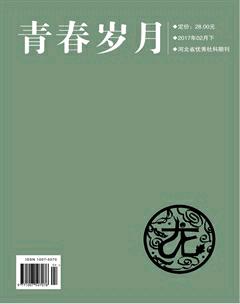Linguistic features of third parties’ interruption in medical interruption
李阳
Abstract:With the rise of interruption study in medical interaction, scholars home and abroad pay more and more attention on it. However, the study mostly focuses on doctors and patients, and the third party is often neglected. In China, medical conversation involving third party is common, so the study of third party in China is significant. This dissertation intends to explore linguistic features of third parties interruption.
Key words:third party; interruption; medical conversation
1. Introduction
Based on Zimmerman and Wests (1975) definition, this paper defines interruption as follows: the interrupter intrudes the current speaker's turn-taking structure, which occurs at non-turn construction units, leading that the speaker does not express a complete turn or meanings. In the following, the author intends to illustrate these features.
2. Phonetic features
2.1 Rushing speed
Rushing speed means that the speed of speaking suddenly increases. The combination of “more than” symbols indicates that the talk between them is compressed.
Example 1:
醫生:几点磕的?
病人:晚上8点了吧。
陪同:应该。
医生:晚上是吧?
陪同:40分钟前把差不多。
When doctor inquire the injured time to make a diagnosis, patients and third party answer the doctors question simultaneously. After their answers, the doctor intends to further confirmation of injury time. Third party make a hurry interruption by making a rushing speed.
2.2 Stretching speed
Stretching speed means that the speed of speaking suddenly decreases, symbolizing the “less than” marks. They can indicate a stretch of talk is slowed.
Example 2:
陪同:那您看这个结果是什么。
医生:尿的这个里边儿,里边儿有个潜血。一般有两种可能。第一种可能是有肾结石,另一种可能就是泌尿性感染。
陪同:泌尿性,泌尿性感染。
Third party aims to inquire diagnosis results. In line 3, detailed explanation is given by the doctor. Before the doctor gives the second possible findings, third party gives his reasoning to interrupt marked by the “less than” marks.
3. Lexical features
3.1 Minimal response
When third party interrupts others, some minimal response such as那, 那个 are used. However, in different situations, these words function differently.
3.1.1 Anaphora
Anaphora refers to the same entity as a prior linguistic expression refers to.
Example 3:
医生:所以这个需要检查。
医生:照个CT把。
陪同:那能照出来眼睛么?
The doctor suggests that patient should do a check to confirm under CT check. In the line 3, the third party interrupt the doctor by using the minimal word “那”.
3.1.2 Cataphoric reference
Cataphoric reference means that the same entity happens in the later expression.
Example 4:
陪同:那就写那个周一的日子吧,反正周六日。
医生:它是自动生成的时间,只能是从今天开始。
第三方:那,第三针是不是周一打?
Third party and doctor are discussing the time of injection. When the doctor corrects the accurate injection time, third party interrupts at the line 3 to by using the deixis “那”, which refers “第三针”.
3.2 Social deixis
Social deixis means that information of concerning social identities of participants or the social identities of participants or the social relationship between them.
3.2.1 Ordinary address
Ordinary address commonly is used in third parties interrupting patients. In the data, second personal pronounce“你” is used.
Example 5:
患者:这个药不吃了吗?
医生:吃。你一天
患者:那:
陪同:你别问了我们知道。
患者:哦。
The patient initiates a question whether the medicine needs taking and doctor answers. Additionally, when the patient intends to inquiry more questions, third party interrupts by the usage of “你”.
3.2.2 Honorifics
Different from the previous one, honorifics are used to refer doctors. When third party interrupts doctors, second personal honorific “您” is used to show his respect.
Example 6:
病人:就是咱那(打斷)。
医生:把吃这些药,这次可能就是过敏,有点过敏,但是没事。
陪同:那您是想说那个。
The doctor indicates that patient may be allergic to drugs, third party interrupts with incomplete meanings by using the second honorific “您”.
4. Structural features
Structural features connect with grammar. In medical conversation, interruptions function closely relates with grammatical clauses.
4.1 Declarative clause
Thompson (2008) refers that statement are most naturally expressed by declarative clauses.
Example 7:
医生:恶心吐吗?
病人:不恶心吐。
第三方:她原来吧,一直说她有那个肠子有气儿。
医生:肠梗阻啊?
When the doctor asks whether the patient has nausea, third party takes the floor to state. Such interruption is stated in the form of declarative clause.
4.2 Interrogative clause
As Thompson noted (2008), questions are raised in the form of imperative clause.
Example 8:
陪同:那就写那个周一的日子吧。
医生:它那是自动生成的时间,只能是从今天开始。
第三方:那,那个第三针是不是周一打?
Third party intends to negotiate the injection time at Monday but the doctor shows that injection time is started from today. Third party interrupts. The initiated interruption is in the form of interrogative clause.
5. Summary
This chapter is mainly based on qualitative research, which combines terms and detailed examples. After the discussion, linguistic features are three aspects: phonetic features, lexical features and structural features. In the first aspect, features include rushing speed and stretching speed; lexical ones are concerned with minimal response and social deixis; the last are declaration clause, imperative clause.
【References】
[1] Roter, D. (2006). Foreword.In Heritage, J. & Maynard, D. W. (eds.). Communication in medical care: Interaction between primary care physician and patients (pp. 214-247). Cambridge: Cambridge University Press.
[2] Sacks, H., E.A. Schegloff., & G. Jefferson. (1974) A Simplest Systematics for the organization Turn-taking in Conversation. Language in society, 596-753.
[3] Schegloff, E. A. (2000). Accounts of Conduct in Interaction: Interruption, Overlap, and Turn-Taking. Handbook of Sociological Theory.
[4] 梁 婷. 美國医生和患者对话的会话分析[D]. 长春: 吉林大学, 2007.
[5] 刘晓佳. 第三方在陈述病情时所起的作用[D]. 太原: 山西大学硕士论文, 2011.

